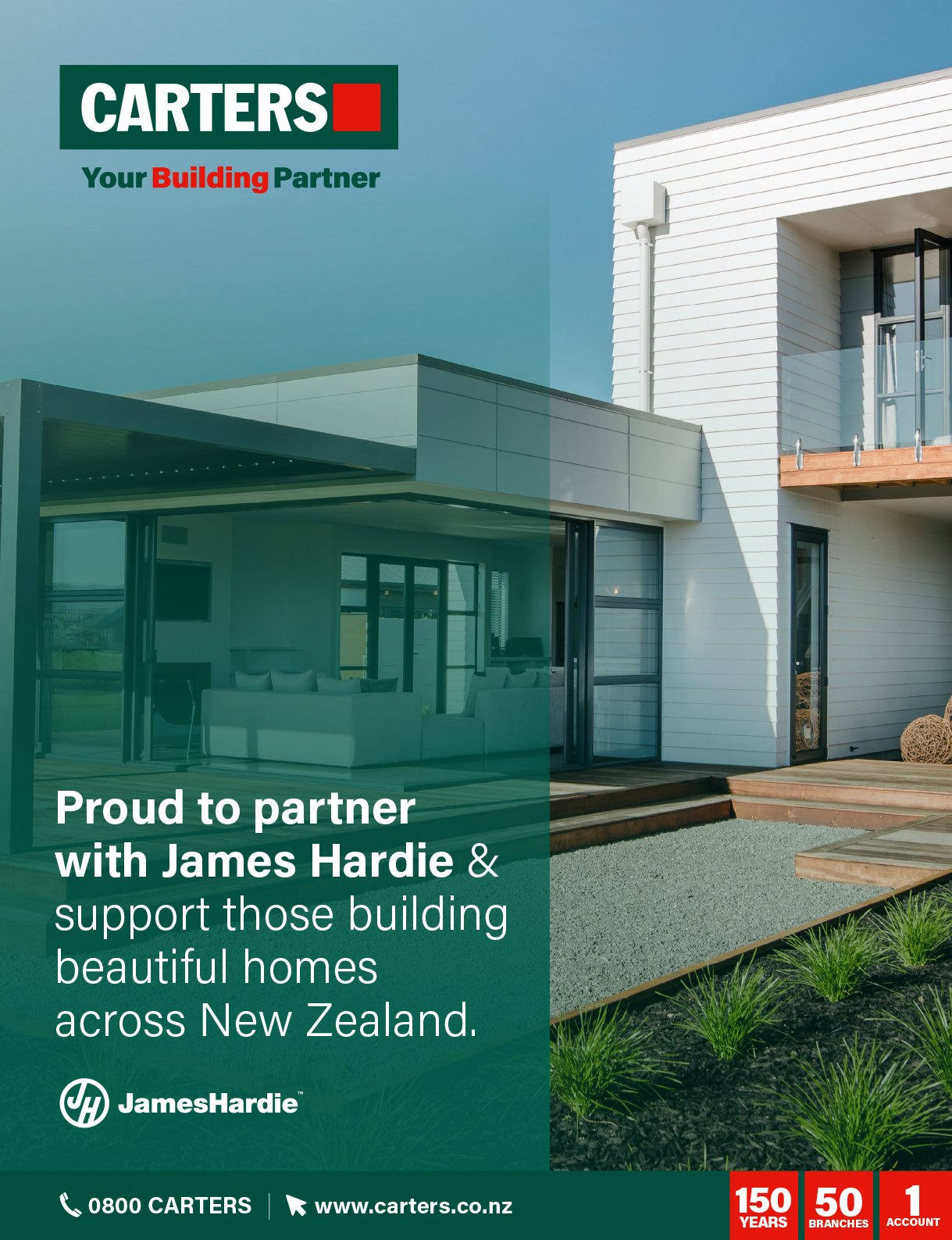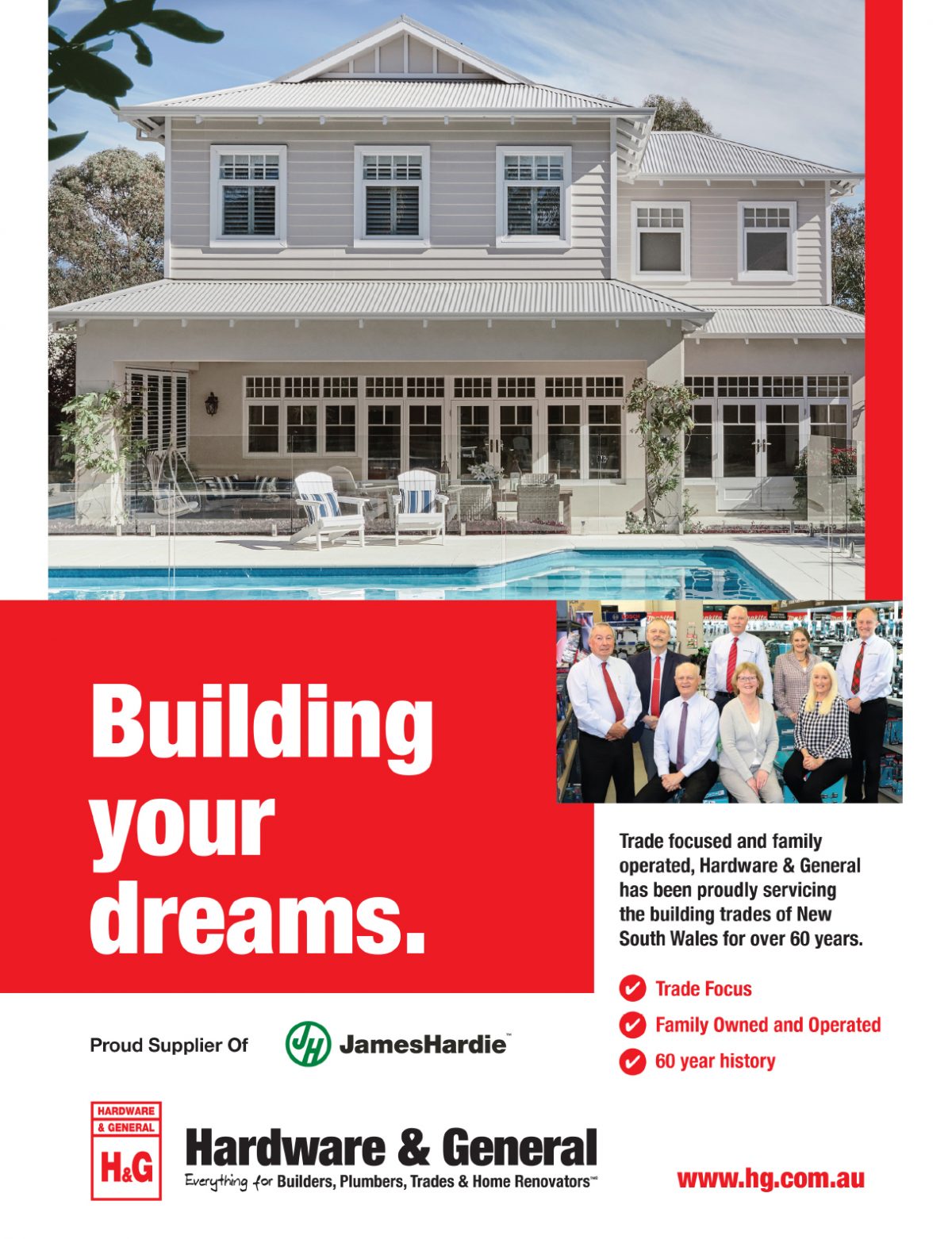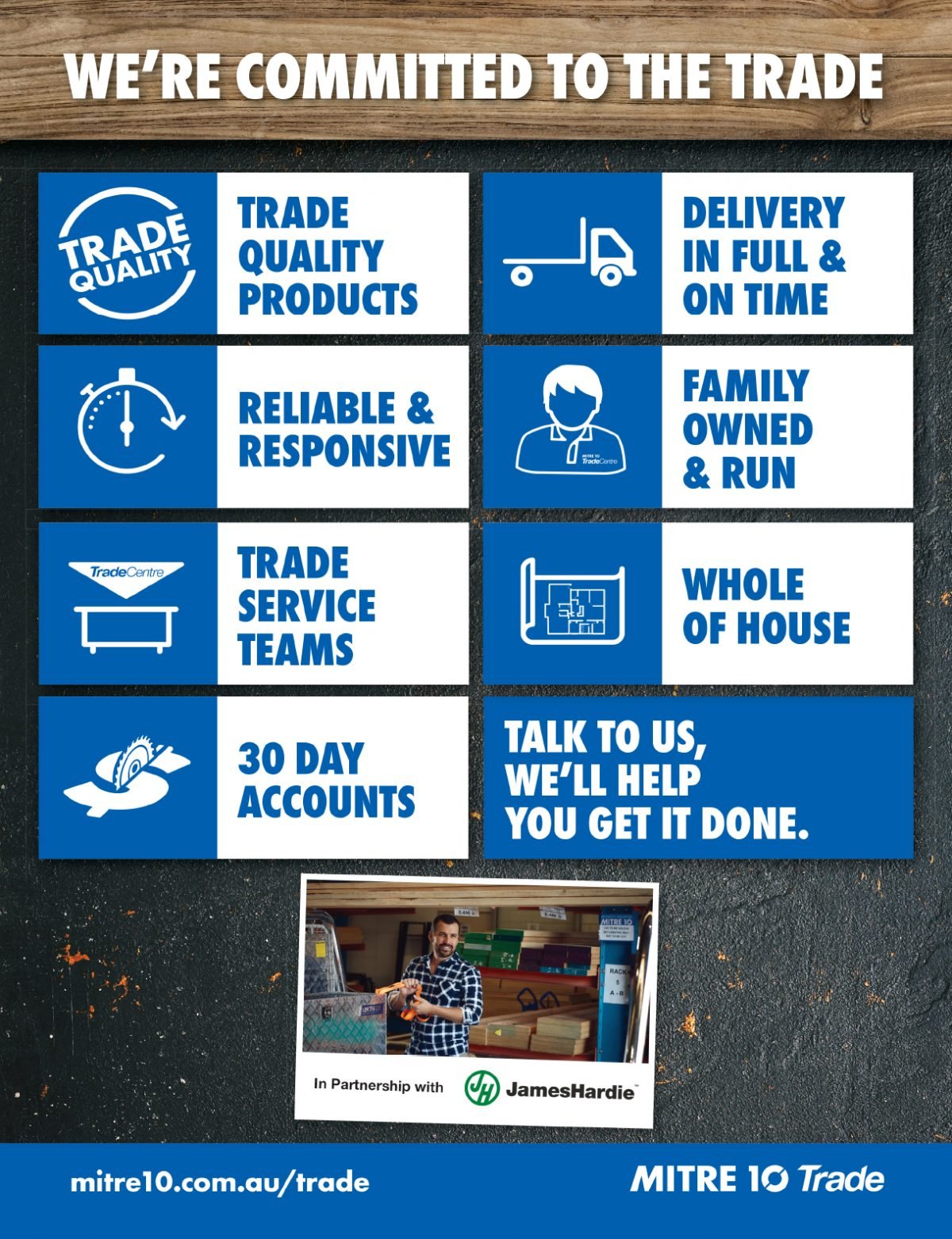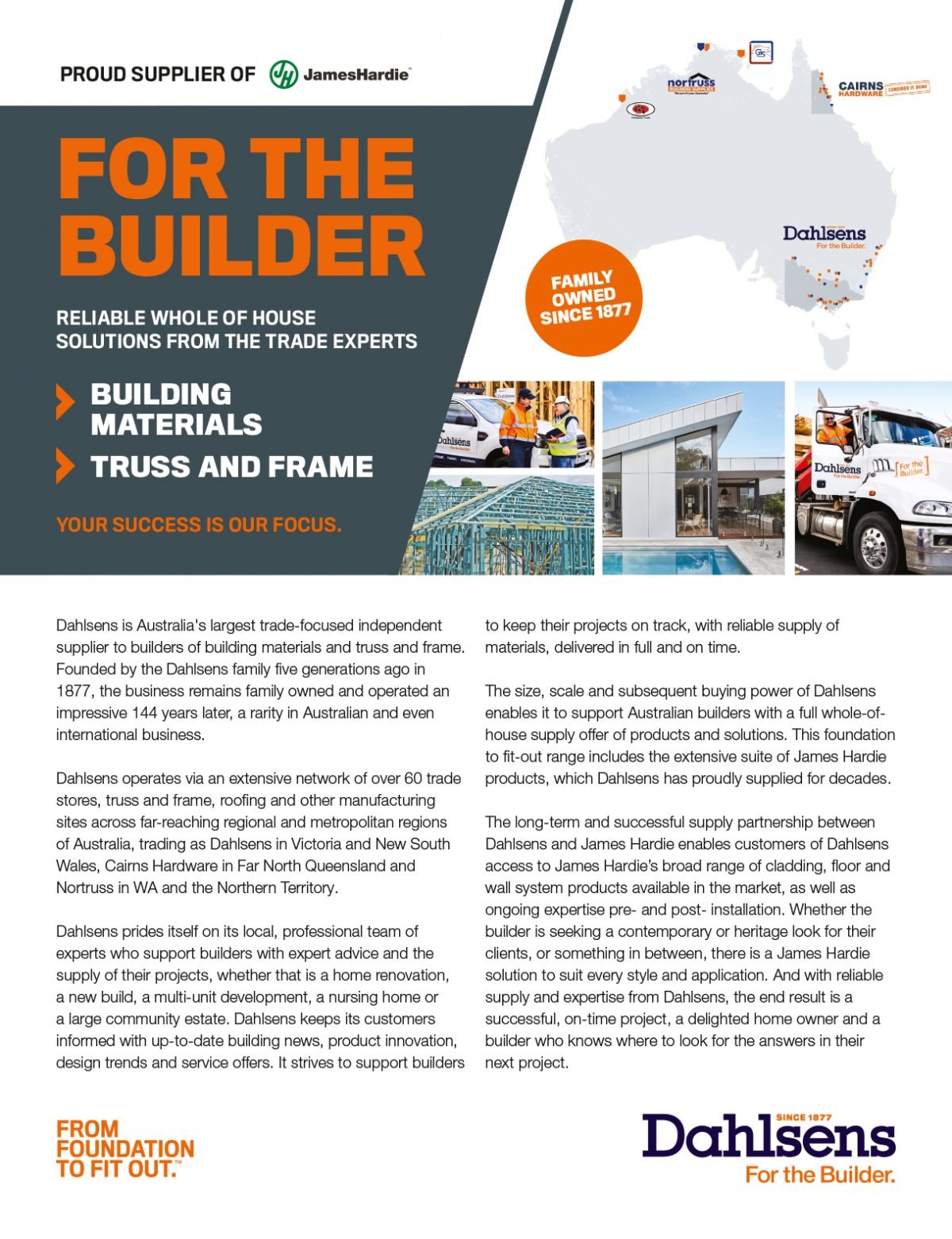Detail. Intricacy. Aesthetic. A dream home isn’t built by accident, it’s built by intention. An intention to not only look beautiful but to perform beautifully as well. An intention that takes into account those who will be creating memories within its four walls; the walls that keep them safe and snug in a world that can sometimes feel anything but.
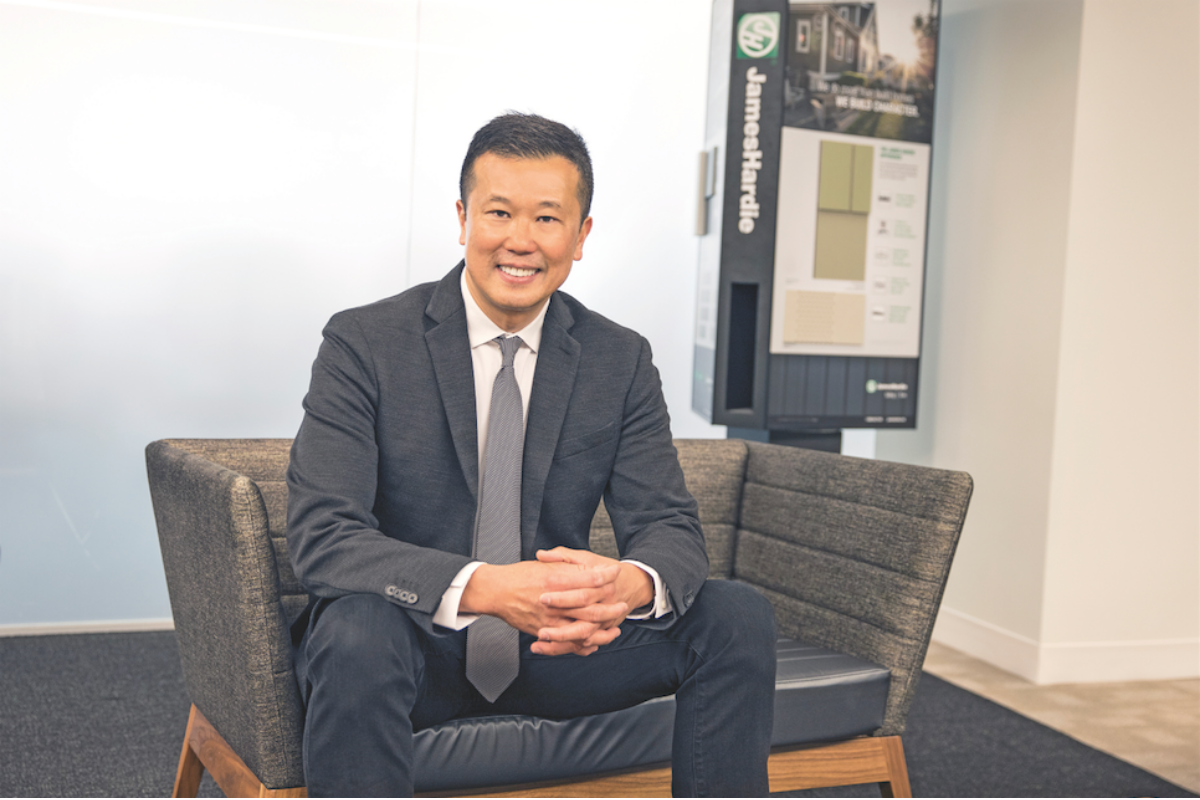
James Hardie gets this. As the world’s number one producer and marketer of high-performance fibre cement and fibre gypsum building solutions, the company understands the concept of home as a sanctuary, as a canvas for self-expression without compromise.
That’s why it’s dedicated to providing premium, quality solutions that enable endless possibilities for design and aesthetics while also delivering what matters most — peace of mind.
“What’s so unique about our company now and, particularly moving forward, is that we have the technology and the capability to deliver a different look, shape and size of our Hardie™ product to homeowners whether they’re looking to build new or renovate and remodel. In North America, we also offer them more than 700 different ColorPlus® Technology finishes. And not only do we deliver that aesthetic, but the product itself is also very durable and low maintenance,” explains CEO Jack Truong.
“At the same time, our products are non-combustible and water-resistant. So, if you think about all the effects of global warming and climate change around the world – like the hurricanes in the US, the wildfires in Australia, and the flooding in Europe and elsewhere – our products not only provide the pride and joy of aesthetic beauty on the homeowner’s exterior, but their durability and weather resistance helps protect their home, giving them peace of mind.”
Our global outlook gives us the opportunity to become a driving force to create design changes around the world.
In light of the pandemic, people are spending more time than ever at home. This change of behaviour combined with a global housing price boom, which sees many homeowners choosing to remodel rather than buy new, is fuelling new trends – trends that put a home’s exterior in the spotlight. And James Hardie couldn’t be in a better position to take advantage of the opportunity.
“We feel that we are now in the right place at the right time, and we’ll help drive the change to support this new consumer behaviour,” Jack says. “With the recent phenomenon of COVID-19, people want to invest more time outside in their yard. This means they’re now exposed to the outside of their home even more, so there’s this heightened need for making the exterior of their home truly beautiful and unique while providing great protection for their family.”
Think global, act local
There are a lot of building material companies in the world, but very few of them are global entities. And the reason is simple: it’s very expensive to ship material around the globe. Even more, construction styles vary significantly from one country to another, making it even more challenging for many companies to break into the market and become profitable in their global pursuit.
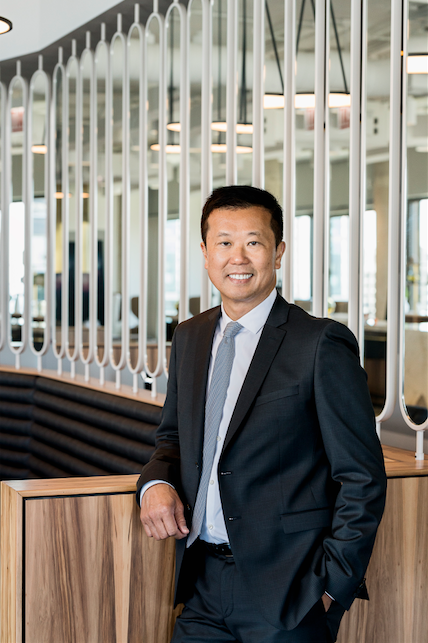
“The housing markets around the world have always been very regional-based. Even within a country or region, the style of homes varies from one part to the other and then, of course, from one country to another. The tastes are very localised,” Jack points out.
“But what’s unique about our company is that we are a global company with deep and expansive operations in North America, Western Europe, Australia, New Zealand and the Philippines. We also have sales and marketing operations, manufacturing, research and development, and supply chains in each of the regions to serve our customers. Having this position as a global company gives us a front-row seat to design trends from around the world.”
And the best thing about these trends, Jack reveals, is that they often move from one country to another, which is good news for James Hardie – it doesn’t have to constantly start from scratch, wasting time and resources. It already has the know-how and deep supply chain integration, allowing it to ramp up fast and deliver.
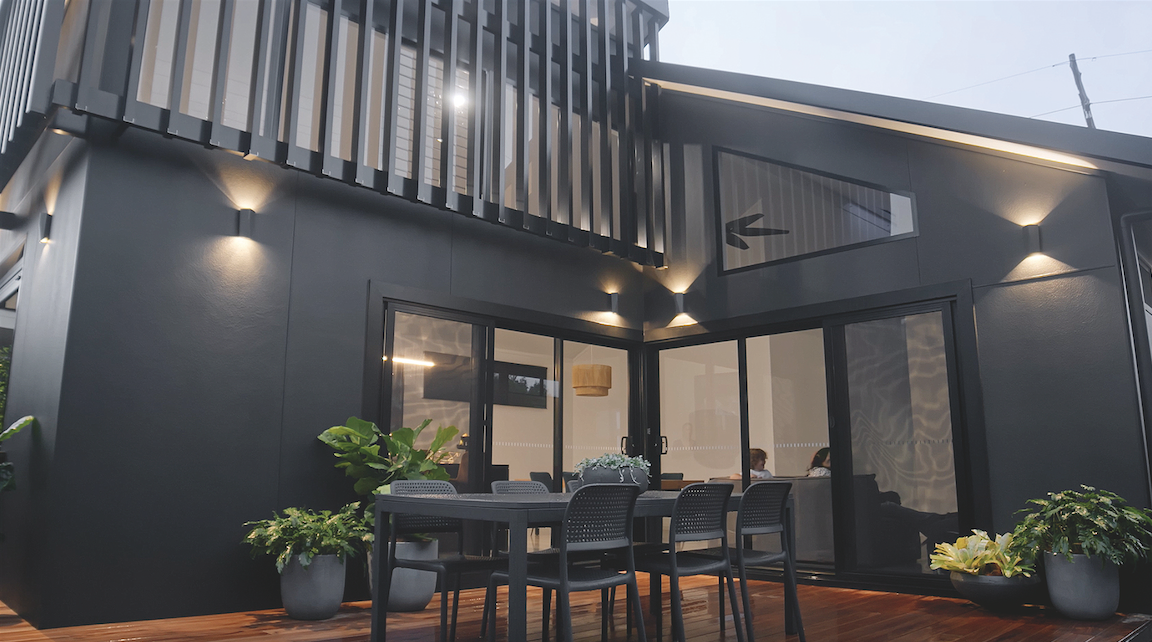
“We’re a big believer in that what’s old in one area is new in another,” he says. “For example, the modern- and contemporary-style homes that we see today around Australia, particularly in Sydney, was a trend that started there about a decade ago. And then that trend moved to Northern Europe, primarily in Scandinavia, particularly Copenhagen and Sweden. It made its way over to the US about four or five years ago, predominantly in areas along the West Coast from Southern California up to Portland, Oregon and Seattle, Washington, and then in the south-east in Atlanta, Georgia. So, we were already there, ready with the right product, our Hardie™ Fine Texture Cladding, which provide contemporary textures and clean, architectural lines, to serve our customers.”
Now, the same is happening with the farmhouse style — a style that perfectly showcases the Hardie™ line of products. “The farmhouse style is popular in the Midwest in the US, and now it’s emerging in Australia, where it is called the Scandi Barn style,” Jack shares.
“And because we already offer the different types of exterior products to cover the farmhouse style from our experience in the US, when the Scandi Barn trend becomes big in Australia, we already have the products and marketing to really help our customers accelerate the design change in their homes.”
We have replaced so many brick and stucco homes with Hardie™ brand exterior products here that we’re pretty much synonymous with home exteriors in the country now.
James Hardie was also instrumental in bringing the iconic Hamptons-style beach home to Australia’s coast just under a decade ago. The company took a group of local builders to the Hamptons in New York to show them up close just how remarkable the design is and how applicable it would be for Australia’s coastline.
“Now, we’re really pushing the Hamptons look, and it’s becoming more of a mainstay in our Australian portfolio because our products are perfectly suited for that,” he says. “They have that quintessential beach look with shiplap products that must also be resistant to the elements of a tough environment by the coast.” As a global leader, James Hardie doesn’t just deliver on these trends, it drives them.
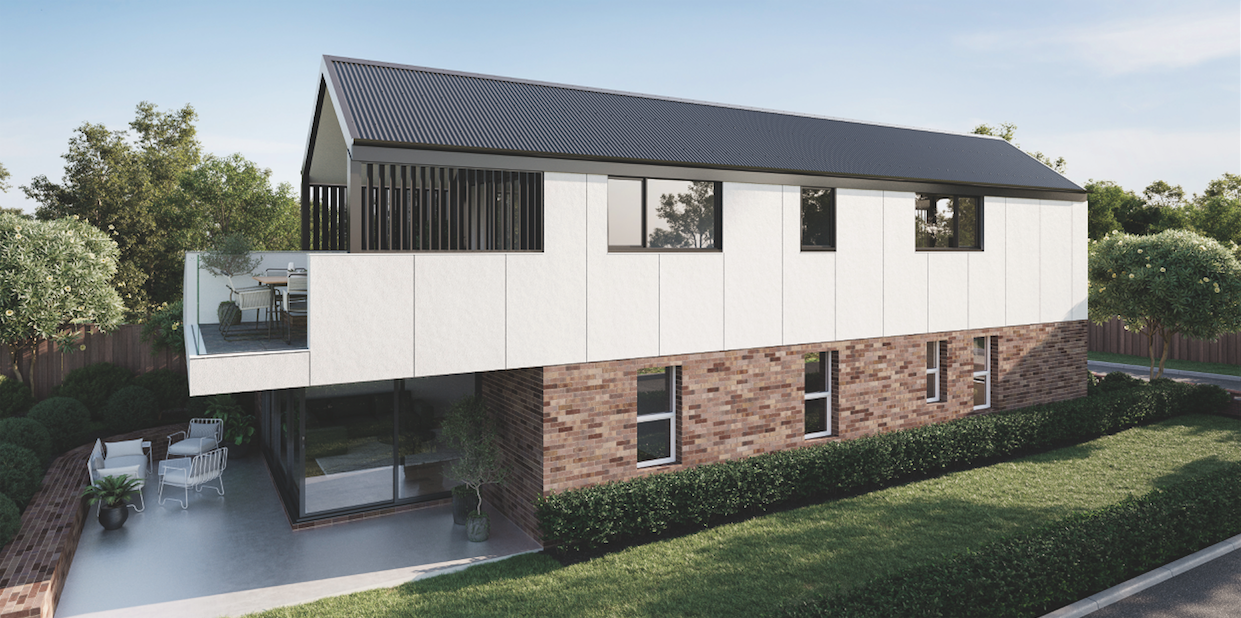
“We are the trendsetter,” Jack states proudly. “We see these trends evolve, and then we develop innovative products in one area and later get to introduce them to a new location. Our global outlook gives us the opportunity to become a driving force to create design changes around the world. It’s a true benefit of being a globally connected company.”
Green and lean
Like other industries around the world, the construction industry contributes to global warming, emitting large amounts of carbon dioxide with each new project. As infrastructure increases, so too does pollution and waste. And as the output of construction continues to multiply, so can its damaging effects.
Aware of these issues and passionate for change, James Hardie embraces sustainability and weaves it into every step of its energy-efficient operations. Its products have been manufactured with an emphasis on reducing environmental impacts by way of using sustainable, plantation-grown timber and abundant, natural raw materials.
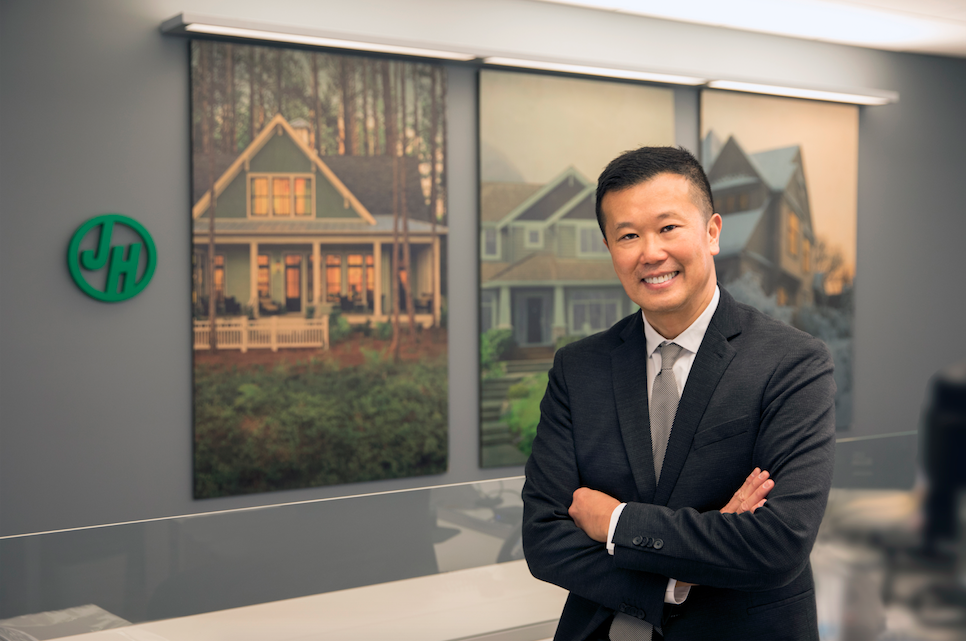
Thanks to this, its products have a smaller footprint on the world compared to many others on the market. “Sustainability is ingrained in our operations. It’s something that’s important to us, and it’s also something that excites us. For us, it’s truly about how we’re building products that help the environment,” Jack says.
“Our products last a long time; we offer up to 30-year warranties. And they’re low maintenance too. So, from an environmental standpoint, you’re not having to repaint or redesign your home as often as you would when using other materials.
Secrets to success
Give your enterprise the best chance for success with these expert tips from Jack. Build a deep, strong, aligned, and connected leadership team that drives your strategy forward. Remember these words from Steve Jobs: “If you want to go fast, go alone. If you want to go far, go together.” Develop a clear and specific vision and mission – and relentlessly execute towards them every day. Check progress frequently, and adjust and adapt as needed. Lead by example and empower your employees to take ownership and accountability of their specific aspect of strategic initiatives – foster a collaborative and engaged team environment.
“At the same time, we provide alternatives to stucco, render, brick and stone, which are heavy to build with and also take a long time to build, increasing costs. Our products end up saving homeowners money in the long run while helping developers and builders build homes faster.”
More than building homes, James Hardie takes a stance that it’s building communities, sustainable communities. According to Jack, the company puts great care into “thinking global but acting local”, ensuring to source locally, employ locally and deliver locally.
“It’s really about creating jobs within a community – 98% of our employees are hired locally near where we operate,” he confirms. “At the same time, we ship our products within the areas that we operate, so that the homes are built in a community where we have our manufacturing located. In doing this, we help the environment by lessening our carbon footprint, lowering our emissions and building homes faster without using labour-intensive and more costly material. We are intent on helping to create a better world and a more joyful community through better-looking and better-protecting homes. It’s something we’re very proud of.”
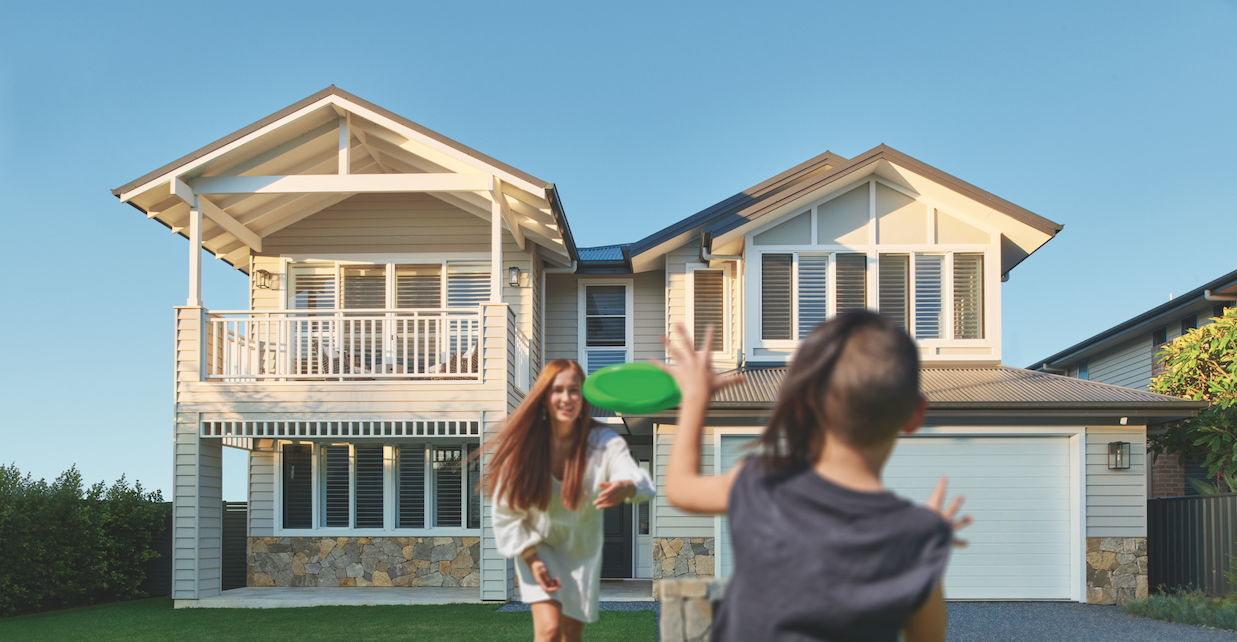
Along with its focus on sustainability, James Hardie is also passionate about operating lean. More than benefiting the company’s bottom line, its world-class manufacturing naturally reduces waste, improves employee and customer satisfaction, all while allowing it to leverage its scale.
“We are the largest fibre cement producer in the world, but that will only benefit us if we take advantage of our scale and operate with the same standard across the globe,” Jack reflects.
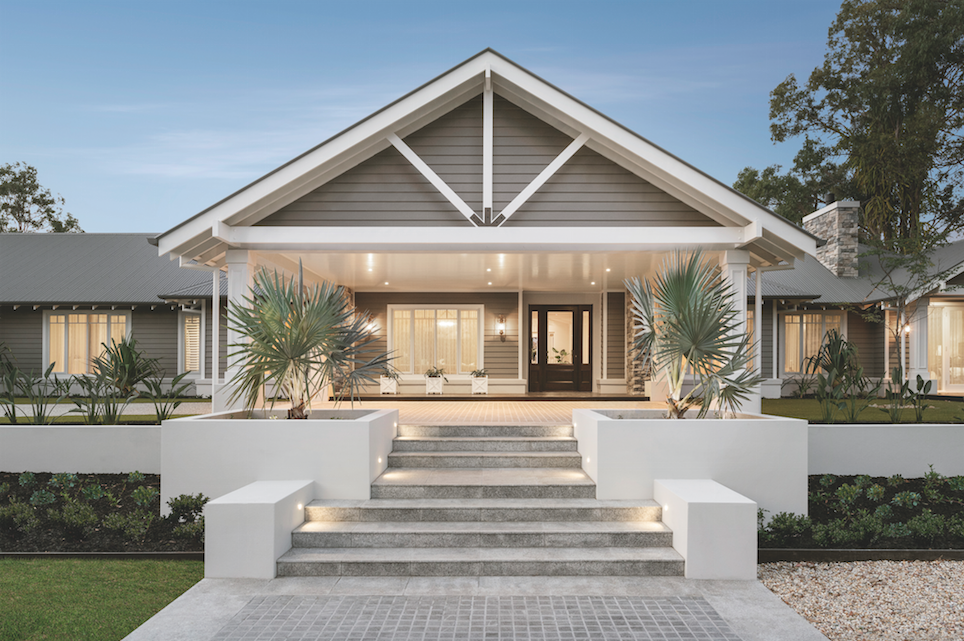
“So, we have a unique operating system based on being lean, which we call the Hardie manufacturing operating system, that allows us to connect all of our manufacturing plants around the world and run off one standard operating procedure that’s really about driving continuous improvement based on the customers’ needs. As these needs change, our manufacturing plants and processes must also change accordingly. Therefore, we focus on the needs of the customers, and then look back into our operation to make sure that we cut out the waste in our processes that don’t add value to our customers.”
When every plant runs on the same procedure, Jack explains, it reduces the variation in product quality and output, creating more value for the customer. At the same time, it also cuts waste while saving employees’ time and effort. “Operating lean has also helped to reduce the amount of turnover in our company significantly,” he shares.
We are intent on helping to create a better world and a more joyful community through better-looking and better-protected homes.
“The first year that we implemented this lean operation, our attrition rate was around 20%. One year later, that dropped to approximately 13%, and now, it’s trending towards 9%. There’s a lot of benefit when you have less attrition. You have engaged employees, and you don’t have to continually go out and hire new ones. When you execute lean manufacturing correctly, it reduces waste beyond products and material, allowing our manufacturing teams to work more effectively.”
A magnitude of opportunity
While new construction is a good chunk of James Hardie’s business, Jack says the company finds a lot more opportunity when it comes to renovations. In the US, for example, there are roughly 80 million, owner-occupied homes and a little more than half of them are more than 40 years old. That means the exterior of those homes is ready for a refresh.
“If we take just 5% of those 44 million homes, then that’s 2.2 million homes that can and should be re-sided now,” he says. “And that’s twice as many as the number of new-construction, single-family homes that are being built each year. That presents a magnitude of opportunity for us.”
However, Jack admits that for a while, the company had a hard time connecting with the homeowner. For one, it was uncharted territory at first, as no exterior brand in the industry was really talking directly to the homeowners. And two, well, James Hardie was simply trying to sell to the wrong homeowner. Unlike with builders, who are predominantly male, the decision-makers at home for re-siding projects are actually female.
We’re a big believer in that what’s old in one area is new in another.
Once it realised this, it wasn’t long before the company shifted its strategy to empowering the woman of the house to realise her dream home. “Now, the key strategy for us is about creating marketing capabilities to reach those female homeowners who we call ‘Christines’ to tell them about the different James Hardie solutions that can help them make better decisions when it comes to re-siding their homes,” he explains.
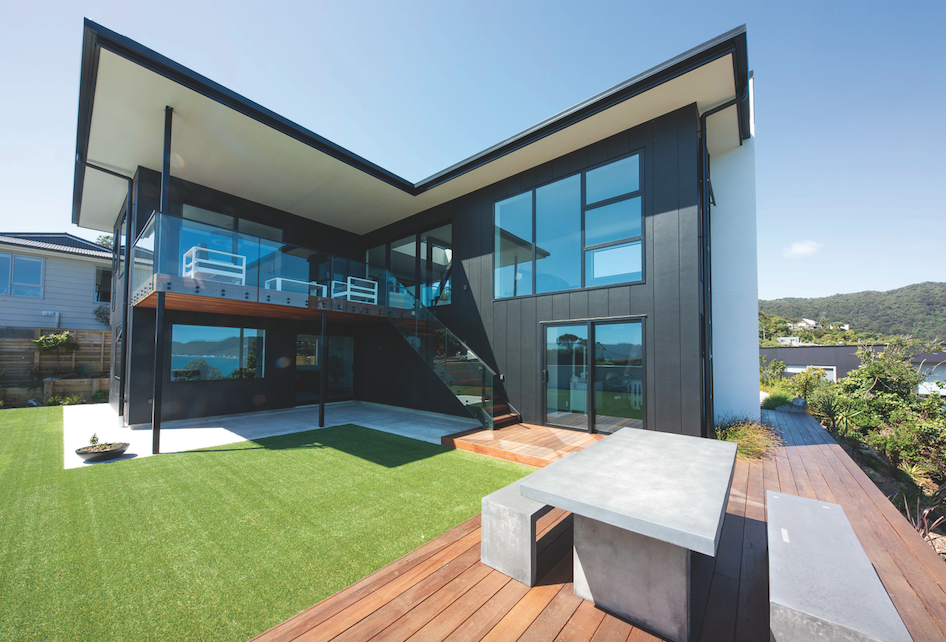
With the launch of the company’s It’s Possible™ campaign, a 360-degree marketing approach inclusive of television commercials, programmatic digital, social media, public relations, influencer and dynamic media partnerships, the brand uses the power of emotional storytelling to illustrate the meaningful ways families find comfort, connection, joy, long-lasting beauty and protection from their James Hardie home over the years – a sentiment that resonates with the ‘Christines’ of the world.
“Once we create awareness with Christine about our products, we know she’ll go to the website or a social media platform to learn more about them and check us out,” Jack says. “She’ll see how our products can be a fit for her home. Then, we will engage with her, provide samples and direct her to the right contractors.
“And that will all work to close the gap in terms of allowing her to make a quicker, well-informed decision that sees her happy with her home for many years to come.” It’s a tall order, being able to deliver new innovations to the market that bring joy and protection, but James Hardie does it flawlessly. In fact, it’s been doing it since it was founded in 1888 in Melbourne.
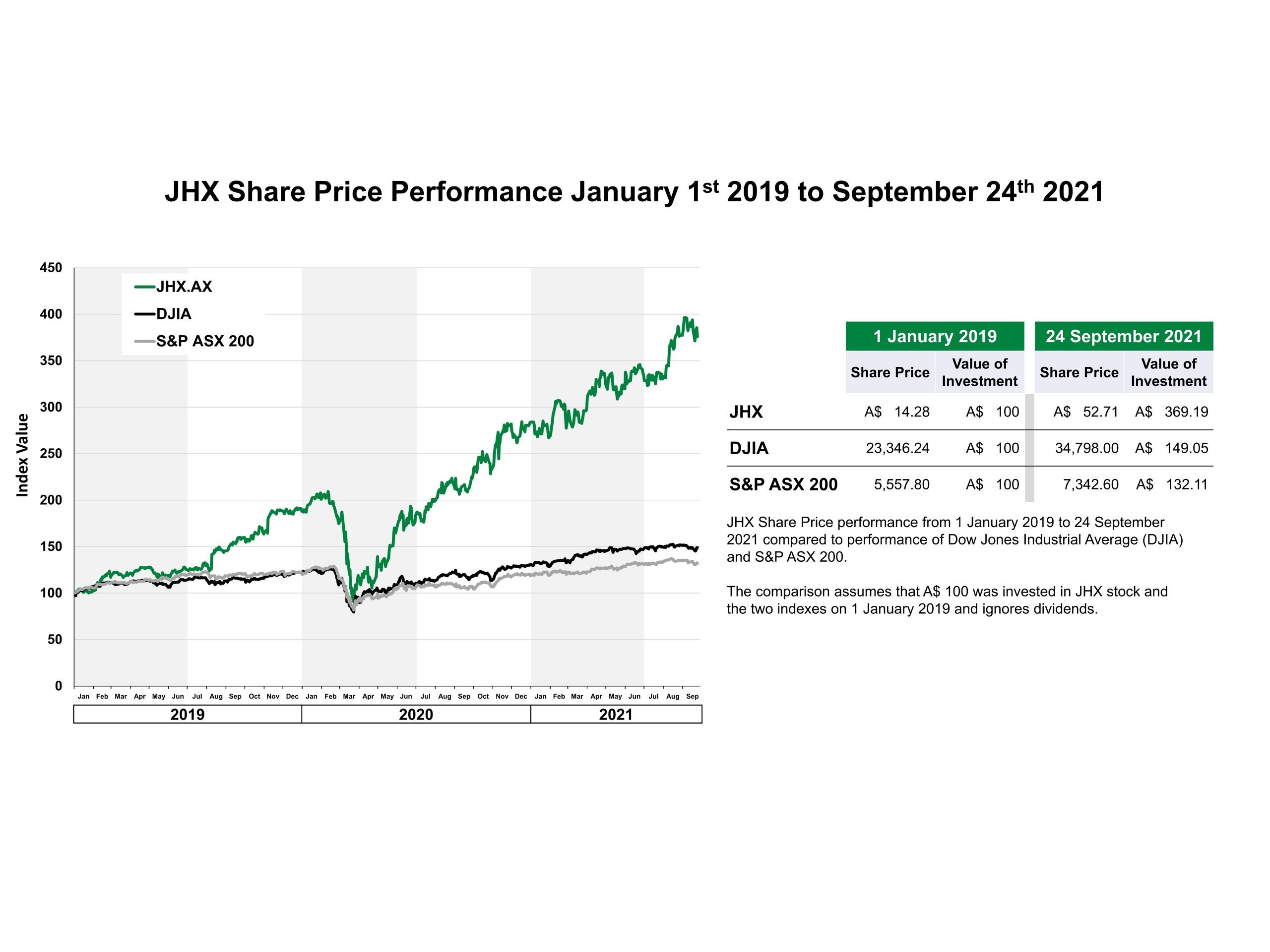
“Australia is where James Hardie started. We’ve been in the market here for a long time,” Jack reflects. “In fact, we’re the ones that created the fibre cement category in Australia. And we have replaced so many brick and stucco homes with Hardie™ brand exterior products here that we’re pretty much synonymous with home exteriors in the country now.”
Proudly supported by:

